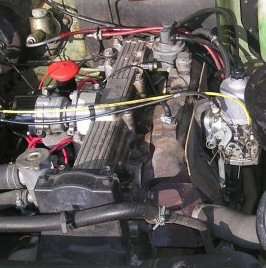BL O-series engine
The BL O-series engine is a straight-4 automobile engine family that was produced by the Austin-Morris division of British Leyland (BL) as a development of the BMC B-series engine family. (See also another B-series successor, the BMC E-series engine.)
| BL O series | |
|---|---|
 | |
| Overview | |
| Manufacturer | British Leyland Motor Corporation Austin Rover Group |
| Production | 1978–1993 |
| Layout | |
| Configuration | Straight-4 |
| Block material | cast iron |
| Head material | cast iron |
| Valvetrain | SOHC |
| Combustion | |
| Fuel system | Carburetor or Fuel Injection |
| Fuel type | petrol |
| Cooling system | water-cooled |
| Chronology | |
| Predecessor |
|
| Successor |
|
Introduced by BL in 1978 in the rear wheel drive Series 3 Morris Marina and the smaller engined versions of the front-wheel-drive Princess, it was intended to replace the 1.8 L B-series unit. The main advance over the B series was that the new unit was of belt driven overhead camshaft configuration, with an aluminium cylinder head.
Offered in the unusual capacity of 1.7 L as well as 2.0 L, it proved to be reliable and was widely used in BL vehicles. These included the rear wheel drive Morris Ital of 1980 (1.7 L or 2.0 L with an automatic gear box), the rear wheel drive Rover SD1 of 1982 (2.0 L only), and 1.7 L and 2.0 L in the front wheel drive Austin Ambassador – in fact the only engine offered in this model. In 1984, it was reworked for installation in high specification 2.0 L versions of the front wheel drive Austin Maestro and Austin Montego, where it was later optionally available with fuel injection or turbo-charging. This installation of the O series was adapted for use with the Honda PG-1 end-on manual gearbox, replacing the gearbox-in-sump design traditionally used on British Leyland front-wheel-drive products. The 1.7 L O series was not used in these vehicles, which featured R- and later S-series 1.6 L units. The cylinder blocks of the later transverse and earlier longitudinally mounted versions of the engine are not however interchangeable owing to differences in the gearbox mounting flange.
In 1986, BL collaborated with Perkins to convert the O series to run on diesel. The oil-burning versions, known as the Rover MDi or Perkins Prima, proved to be highly successful in the Maestro and Montego, and helped sustain the ailing mid-sized models into the 1990s. Perkins successfully marketed the engine under its own brand in the industrial and marine sectors.
By 1987, British Leyland (now known as the Rover Group) equipped the O series with a 16-valve cylinder head for the Rover 800. This 2.0 L unit was known as the M series, and was further reworked into the T series in 1992. The original 8-valve version of the O series was also briefly used in budget versions of the Rover 800.
2-litre O series
A notable advantage of this particular O-series engine is that the cylinder head does not require modification to run on unleaded petrol due to having hardened valve seats. Other O-series engines, however, cannot run on unleaded without modification of the cylinder head or use of an additive.
Vehicles using the O series
Examples of vehicles using a version of the O-series engine:
- Austin Maestro 2.0 L, 2.0 L Diesel
- Austin Montego 2.0 L, 2.0 L Diesel
- Leyland Sherpa/Freight Rover Sherpa/200/300 1.7 L, 2.0 l
- Princess / Austin Ambassador 1.7 L, 2.0 L
- Morris Ital 1.7 L, 2.0 L automatic
- Morris Marina 1.7 L
- Rover SD1 2.0 L
- Austin Maestro 2.0 L
- Austin Montego 2.0 L
- Rover 820 2.0 L
- MG Maestro 2.0 L
- MG Maestro 2.0 L, turbo
- MG Montego 2.0 L
- MG Montego 2.0 L, turbo
- Naylor/Hutson TF 1700[1]
References
- Mastrostefano, Raffaele, ed. (1985). Quattroruote: Tutte le Auto del Mondo 1985 (in Italian). Milano: Editoriale Domus S.p.A. p. 643. ISBN 88-7212-012-8.